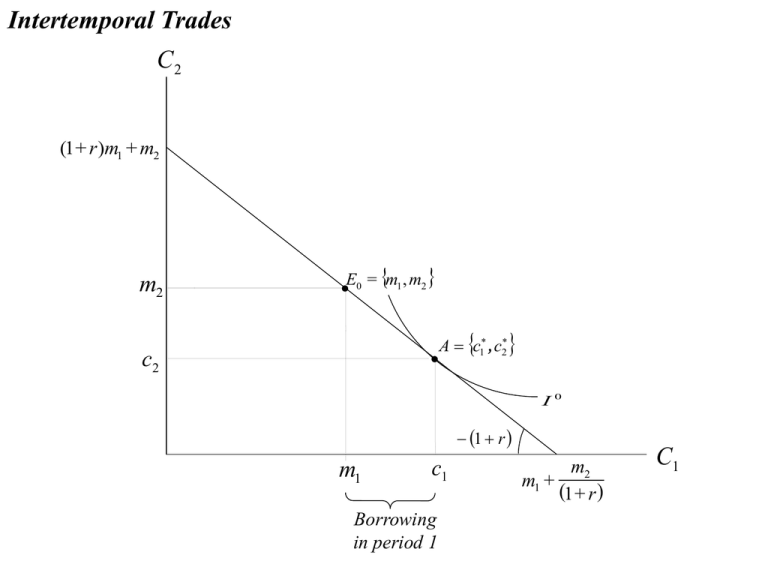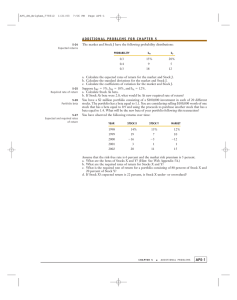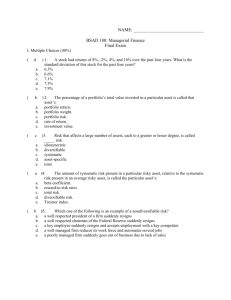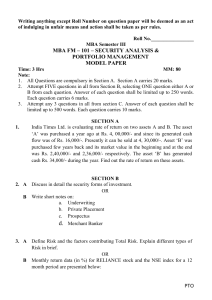Intertemporal Trades • {
advertisement

Intertemporal Trades
C2
(1 + r )m1 + m2
m2
•E
0
= {m1 , m2 }
A c1 , c2
•
c2
I0
1 r
m1
c1
Borrowing
in period 1
m2
m1 +
(1 + r )
C1
Intertemporal Trades
C2
C2
C1 = C2
C1 = C2
C1
Patient preferences
C1
Impatient preferences
Optimal Holding Period for an Asset
FV(t) = 100 + 6t + 2t2 – 0.1t3
$350
24%
22%
$300
20%
FV t
$250
18%
16%
$200
14%
12%
$150
10%
8%
$100
PV t
$50
0
1
2
Time
3
4
5
6
7
8
t*
9
10
11
12
13
14
15
16
17
18
19
4%
2%
Rate of return from holding asset
$0
6%
0%
20
Asset Markets: Debt
Asset Markets: Debt
Risky Assets: Equities
1800
S&P 500
1600
1400
1200
1000
800
600
400
2007
Return: 3.67%
Volatility: 16.02%
2008
Return: - 38.52%
Volatility: 41.10%
2009
Return: 23.44%
Volatility: 27.27%
200
0
1/3/2007
1/3/2008
1/3/2009
1/3/2010
Risky Assets: Portfolios
140.00
S&P 500 and Malkiel Portfolio
120.00
100.00
80.00
60.00
40.00
20.00
2007
Return: 3.67%
Volatility: 16.02%
2008
Return: - 38.52%
Volatility: 41.10%
2009
Return: 23.44%
Volatility: 27.27%
Return: 17.92%
Volatility: 18.05%
Return: - 35.97%
Volatility: 33.14%
Return: 37.35%
Volatility: 20.81%
0.00
1/3/2007
1/3/2008
Malkiel Portfolio
1/3/2009
S&P 500
1/3/2010
Capital Asset Pricing Model
Capital Market Line
Security Market Line
r = E[return of a portfolio ]
r = E[return of a security ]
rx = rf +
rm - rf
m
rm
ri rf rm - rf i
X
rm
rx
rm - rf
rf
rm - r f
m
rf
x
m
cov(rx , rm )
Beta, ≡
var (rm )
1
i
Beta as a Measure of Relative Risk
1
0.8
0.6
0.4
0.2
0
2004
2005
2006
2007
2008
2009
-0.2
-0.4
-0.6
SP500
FLSAX (Beta = 1.46)
VTI (Beta = 1.03)
NCICX (Beta = 0.75)
FMAGX (Beta = 1.25)
Capital Asset Pricing Model
25
Returns
20
15
ri = 3 + 5i
10
5
0
0.0
0.2
0.4
Mutual Fund Name
American Century Heritage A
Fidelity Advisor Equity Growth T
Fidelity Magellan
Putnam International Growth & Income
Fidelity Diversified International
Templeton Growth A
Vanguard 500 Index
Vanguard Total Stock Market Index
Vanguard PRIMECAP
Janis Growth & Income
Dreyfus Premier Balanced B
Dreyfus Founders Balanced A
0.6
Symbol
ATHAX
FAEGX
FMAGX
PNGAX
FDIVX
TEPLX
VFINX
VTSMX
VPMCX
JAGIX
PRBBX
FRIDX
0.8
Beta
1.0
1.2
1.4
1.6
3-Year
5-Year
10-Year
Beta
Returns Beta
Returns Beta
Returns
1.44
20.50
1.17
19.26
0.96
8.42
1.18
8.31
1.16
11.20
1.16
3.34
1.33
6.88
1.03
10.42
1.04
3.53
1.07
12.55
1.03
20.56
0.96
6.90
1.08
14.57
1.02
22.18
0.96
10.85
0.77
5.78
0.85
14.81
0.80
7.01
1.00
5.72
1.00
11.18
1.00
3.43
1.04
6.19
1.04
12.27
1.01
3.89
1.01
9.63
1.06
15.78
1.08
8.50
1.13
6.69
1.05
11.22
0.98
5.84
0.98
4.05
0.90
6.59
0.87
1.43
0.98
3.71
0.88
7.21
Efficient Market Hypothesis
A theory that asset prices reflect all publicly available
information about the value of an asset.
Strong Form: Asset prices reflect all information, public and private,
and no one can earn excess returns
Semi-Strong Form: Asset prices adjust very rapidly to publicly
available new information and in an unbiased fashion, such that no
excess returns can be earned by trading on that information. Semistrong-form efficiency implies that neither fundamental analysis nor
technical analysis will be able to reliably produce excess returns.
Weak Form: Future asset prices cannot be predicted by analyzing
price from the past. Excess returns can not be earned in the long run
by using investment strategies based on historical share prices or
other historical data.
Diversification and Portfolio Theory
Expected Return of a Portfolio (2 investments):
E[rx]= x1E[r1] + x2E[r2]
(x1 + x2 = 1)
Expected Variance of a Portfolio (2 investments):
1,22 = x1212 + x2222 + 2x1x21,2
= x1212 + x2222 + 2x1x2r1,212
Diversification and Portfolio Theory
Portfolio Example
Weights: 0.5
State
1
2
3
4
5
Prob.
0.2
0.2
0.2
0.2
0.2
A
Return
-5.00%
0.00%
5.00%
10.00%
15.00%
0.5
B
Return
15.00%
10.00%
5.00%
0.00%
-5.00%
Portfolio
Return
5.00%
5.00%
5.00%
5.00%
5.00%
E[rx]= x1E[r1] + x2E[r2]
Expected Return:
Variance:
Std. Deviation:
Covariance(A,B)
Correlation(A,B)
5.00%
0.63%
7.91%
5.00%
0.63%
7.91%
-0.0050
-1.0000
5.00%
0.00%
0.00%
1,22 = x1212 + x2222 + 2x1x21,2
= x1212 + x2222 + 2x1x2r1,212
What does a negative beta asset look like?
Was the yen a negative beta asset in 2007 – 2008?
The blue line is FXY, an exchange-traded fund that tracks the yen. The red line is the S&P
500 index. Over the past year, the two time-series look like mirror images of each other.
That is, holding yen seems to hedge U.S. stock-market risk.
Source: http://gregmankiw.blogspot.com/ 29 May 2008
What does a negative beta asset look like?
Was the yen a negative beta asset in 2007 – 2008?
140.00
130.00
Feb. 2007 to May 2008:
Average Weekly Returns
Std. Dev. of Weekly Returns
FXY
0.19%
1.60%
^GSPC
0.01%
2.37%
BLEND
0.10%
0.92%
120.00
Annualized Returns
Annualized Volatility
10.51%
11.56%
0.33%
17.06%
5.29%
6.62%
110.00
100.00
90.00
80.00
70.00
60.00
2/12/2007
5/12/2007
8/12/2007
11/12/2007
FXY
^GSPC
2/12/2008
5/12/2008
What does a negative beta asset look like?
Was the yen a negative beta asset in 2007 – 2008?
160.00
140.00
120.00
100.00
80.00
60.00
40.00
20.00
0.00
FXY
^GSPC
Dealing With Risk: Diversification (Portfolio Theory)
Effect of Additional Investments / Assets on Diversification
Risk and Uncertainty: “Contingent Consumption Plans”
Case 2:
A person with an endowment of
$35,000 faces a 1% probability of
losing $10,000. He is considering
the purchase of full insurance
against the loss for $100.
Case 1:
A person with an endowment of
$100 is considering the purchase
of a lottery ticket that costs $5.
The winning ticket in the lottery
gets $200. 40 tickets will be sold.
$100
Lucky
day
Do not
purchase
Purchase
Do not
purchase
Lucky
day
$295
Pr(Lucky) = 0.025):
Purchase
$35,000
Outcome A:
E x $34 ,900
x $995
Unlucky
day
$25,000
Lucky
day
$34,900
Outcome B:
E x $100
x $31
Unlucky
day
$95
E x $34 ,900
x 0
Unlucky
day
$34,900
Risk and Uncertainty: “Contingent Consumption Plans”
CGood
$35,000
Lucky
day
Do not
purchase
• E
C g0 , Cb0
C g0 $35,000
Purchase
Unlucky
day
Lucky
day
Unlucky
day
C 1g = $34,900
(C
1
g
=C
0
g
A C 1g , Cb1
1
•
- K )
Cb0 $25,000
C
0
b
C g0 K
C
Cb1 $34,900
1
b
Cb0 K K
K = the “expected loss” ($10,000), and K is the insurance premium.
$25,000
$34,900
$34,900
C Bad
Defining Risk Aversion
1. Risk aversion is defined through peoples’ choices:
Given a choice between two options with equal expected values and
different standard deviations, a risk averse person will choose the option
with the lower standard deviation:
If EX1 EX 2 , and 1
2
, then1 2
Given a choice between two options with equal standard deviations and
different expected values, a risk-averse person will choose the option
with the higher expected value:
If 1
2
, and EX1 EX 2 , then1 2
2. Non-linearity in the utility of wealth.
Risk Aversion and the Marginal Utility of Money
Utility
A
l
U3
l
U2
U1
U($)
l
B
D
Risk Premium
l
C
Risk Premium
$0
$99,415
$99,500
$100,000
$
$50,000
U 1 U $50,000
E99
E99,500
U2 U
U2$99
U
,415
,U
500
U 3 U $100,000
Modeling Different Risk Preferences
Utility
U($)
U($)
U($)
$
Classification of Auctions
What is the nature
of the good being
auctioned?
Private values
Common value
What are the
bidding rules?
English ascending
bid
Dutch descending
bid
Sealed bid
Vickrey second
price
Evaluative Criteria for Auctions
Pareto Efficiency
Does the auction design guarantee that the item
will go to the bidder with the highest value?
Revenue or Profit Maximization
Does the auction design guarantee the highest
revenue (or profit) for the seller?
Types of Auctions and optimal bidding strategies
Independent Private Values Auctions
Each bidder knows precisely how highly he/she values the item,
and these values vary across all bidders.
English (ascending bid)
b v
Dutch (descending bid)
vL
b v
n
First-price, sealed bid
vL
b v
n
Second-price, sealed bid
b v
b* optimal bid
v private valuation of bidder
Where
L lowest possible valuation
n number of bidders
Types of Auctions and optimal bidding strategies
Common (or Correlated) Values Auctions
The item being bid has an underlying objective value, but no
bidder knows precisely what that value is.
Winning bids tend to come from those with the most
optimistic estimates.
If estimate errors are randomly distributed around zero, then
the winning bid will be greater than the true value of the item
(the “winner’s curse”):
Distribution of bids:
1
Winning
Bid
0
5
10
True
Value
15






